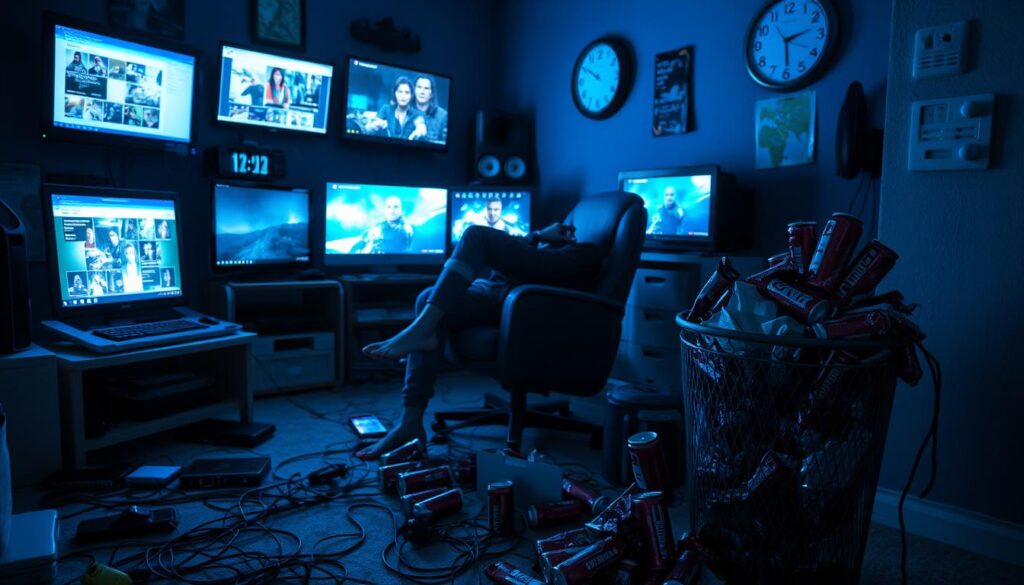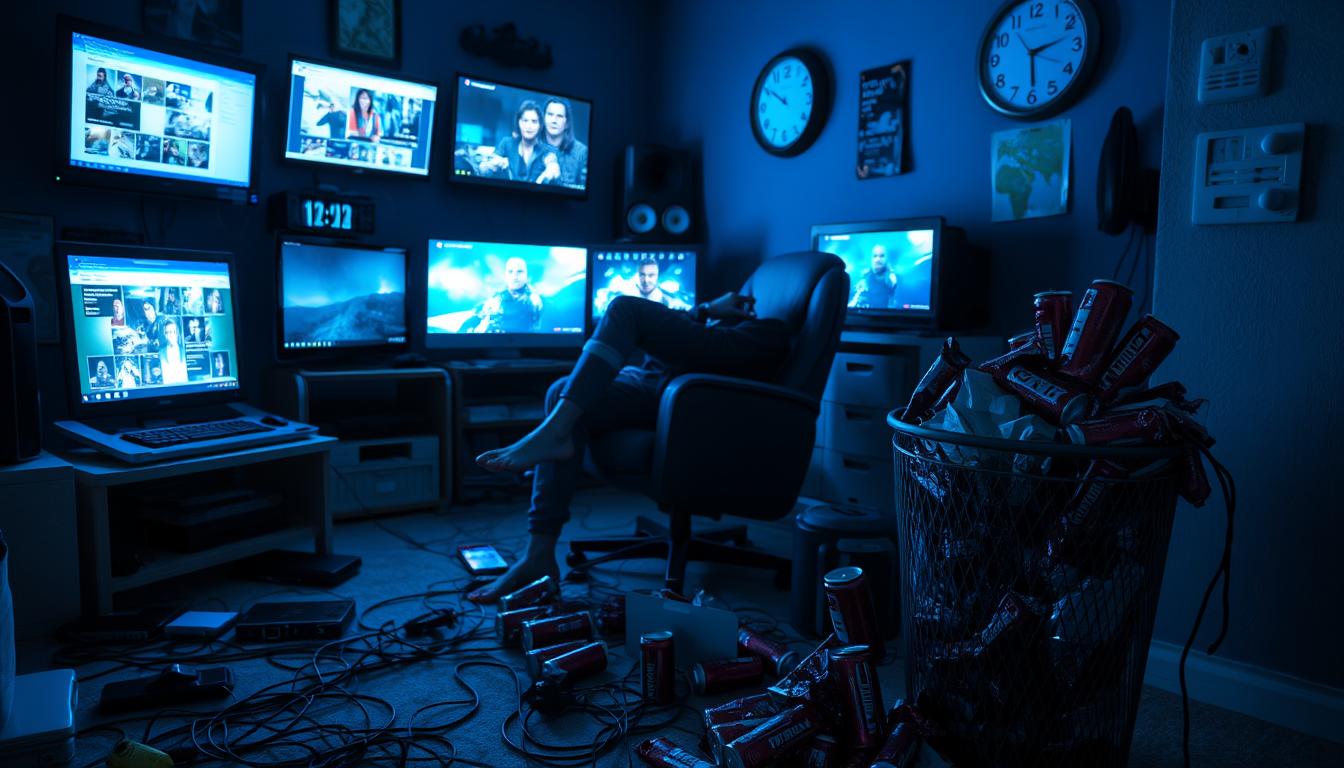In today’s digital world, Australians are spending more time in front of screens. We binge-watch shows on Netflix and scroll endlessly on social media. This has led to a growing problem – screen addiction.
Technology keeps getting better, making it easier for us to stay connected. Smartphones, video games, and TV shows are all tempting. But, getting too caught up can harm our health, relationships, and productivity.

Breaking Free from Screen Addiction: A Modern Challenge
Key Takeaways
- Screen addiction is a growing concern in modern Australia, driven by the pervasive nature of digital devices and platforms.
- The constant availability and allure of digital content can lead to unhealthy habits and compulsive behaviours, negatively impacting various aspects of life.
- Recognising the signs and symptoms of screen addiction is the first step towards breaking free and reclaiming a balanced, healthy relationship with technology.
- Developing strategies to set boundaries, create tech-free zones, and engage in digital detox can help Australians regain control over their digital consumption.
- Seeking professional support and resources can provide valuable guidance in overcoming the challenges of screen addiction and fostering a healthier, more mindful approach to technology usage.
Understanding Screen Addiction in Modern Australia
In today’s world, screens are everywhere, especially in Australia. Cyber compulsion and internet addiction are big problems. It’s important to understand this modern issue well.
Common Signs and Symptoms
Spotting screen addiction early is key. Look out for these signs:
- Constantly being drawn to virtual worlds, like online games or scrolling through social media
- Ignoring important tasks and responsibilities for more screen time
- Feeling upset or anxious when you can’t use digital devices
- Not doing enough physical activities or spending time with others because of screens
Impact on Daily Life and Relationships
Screen addiction can really mess up your life and relationships. People struggling with it might skip personal care, healthy food, and struggle at work or school. It also makes it hard to stay connected with family and friends. Being glued to screens can make it tough to have real conversations.
Statistical Overview of Digital Device Usage
| Metric | Average Australian | Screen-Addicted Australian |
|---|---|---|
| Daily Screen Time | 5 hours | 10 hours |
| Smartphone Usage | 2.5 hours | 6 hours |
| Time Spent on Social Media | 1 hour | 3 hours |
These numbers show how big a problem screen addiction is in Australia. We need to understand it better and take action.
The Science Behind Digital Device Dependence
In today’s world, it’s key to understand why we’re so hooked on our tech. Studies show how digital devices change our brain chemistry and how we think. This helps us see why we can’t put down our screens.
Dopamine, a feel-good chemical, plays a big role. It’s released when we get notifications or likes online. This makes us feel good and want to keep checking our devices.
Also, the way we get rewards online is like gambling. It’s unpredictable, which makes our brains crave more. This makes it hard to stop using our devices.
| Aspect | Impact on the Brain |
|---|---|
| Dopamine Release | Increased dopamine levels associated with digital interactions can lead to a cycle of compulsive behavior and technology dependence. |
| Intermittent Rewards | The unpredictable and variable nature of digital rewards can trigger the brain’s reward system, similar to gambling, reinforcing cyber compulsion. |
| Cognitive Processes | Prolonged digital device usage can impact attention span, decision-making, and impulse control, further exacerbating technology dependence. |
Using devices too much can also change how we think. It affects our focus, decision-making, and self-control. This makes it harder to break free from tech addiction.
“Understanding the neurological and psychological mechanisms behind screen addiction is essential for developing effective strategies to combat this modern challenge.”
By studying why we’re so drawn to our devices, we can find ways to change. This knowledge helps us create better ways to use technology. It’s about finding a balance and making healthier choices online.
Screen addiction (TV, video games, phones)
In today’s world, screens are a big part of our lives. We love binge-watching TV, playing video games, and checking our phones. It’s important to know how these habits affect us and find a healthy balance.
Television and Streaming Habits
Australians watch TV for 2.5 hours a day. Streaming services make it easy to get lost in shows and movies. This can make us less active, disrupt our sleep, and hurt our relationships.
Gaming Disorder Recognition
The World Health Organization says gaming disorder is a real mental health issue. It’s when someone can’t stop gaming, even when it hurts them. In Australia, about 3% of gamers have this problem, leading to social isolation and health issues.
Smartphone Usage Patterns
Smartphones are everywhere, and Australians use them for 2 hours and 12 minutes daily. Social media and notifications can mess with our work, relationships, and sleep. It’s key to manage our phone use for a better digital life.
| Screen Addiction Type | Average Daily Usage (Australia) | Potential Consequences |
|---|---|---|
| Television and Streaming | 2.5 hours | Sedentary lifestyle, disrupted sleep, social detachment |
| Gaming Disorder | 3% of gamers | Social isolation, academic/professional underachievement, physical health issues |
| Smartphone Addiction | 2 hours 12 minutes | Disrupted productivity, strained relationships, poor sleep quality |
Dealing with screen addiction needs us to understand its many forms and effects. By spotting the signs, we can work on a healthier digital life.
Physical and Mental Health Implications
Digital device overuse has serious effects on our health. It can cause eye strain, poor posture, sleep problems, and even social isolation. These are all serious side effects of too much screen time.
Staring at screens for too long can lead to eye fatigue, headaches, and neck pain. The blue light from devices can also mess with our sleep, causing insomnia and disrupted sleep patterns. Plus, sitting for long periods can harm our posture and reduce physical activity, raising the risk of musculoskeletal issues.
The mental health effects of too much screen time are also worrying. Spending too much time in virtual reality or compulsively scrolling can increase anxiety, depression, and feelings of loneliness. The constant need to check notifications and fear of missing out can add to stress and make it hard to focus.
“The more time we spend in the digital world, the more we risk losing touch with the real one.”
It’s important to tackle the health risks of screen addiction to live a balanced life. Setting limits, creating tech-free areas, and using technology mindfully can help take back control and improve our well-being.
Digital Wellbeing Strategies for Australians
Finding a balance between technology and daily life is key for Australians today. To overcome screen addiction, here are some effective strategies for better digital wellbeing.
Setting Healthy Boundaries
Setting clear limits on tech use is vital. This means setting times for screen-free activities, like family meals or bedtime. A “digital curfew” can also improve sleep by avoiding blue light and notifications.
Creating Tech-Free Zones
- Make certain areas in your home tech-free, like bedrooms or dining rooms.
- Get your family involved in activities without screens, like reading or outdoor games.
- Make your workplace tech-free to help employees focus better.
Implementing Digital Detox Plans
- Plan regular digital detox times, like a weekend or a few hours, to disconnect and enjoy the real world.
- Try mindfulness and meditation to lessen the need to check devices constantly.
- Get support from friends, family, or digital wellbeing groups to stay on track.
By using these strategies, Australians can improve their relationship with technology. This leads to better wellbeing and a higher quality of life.
“The first step towards breaking free from screen addiction is to acknowledge the problem and take intentional actions to regain control over our digital lives.”
Breaking the Cycle of Compulsive Scrolling
In today’s world, compulsive scrolling is a big problem linked to internet addiction. It’s when we keep scrolling through social media, news, or other online stuff. This can hurt our work, mental health, and happiness. To stop this, we need to know why we do it and find ways to control it.
The brain’s reward system is a big reason for compulsive scrolling. The thrill of getting a notification or “like” can make us want more. Also, the fear of missing out (FOMO) and wanting to stay connected keeps us scrolling.
- Know your triggers: Spot the times, feelings, or habits that make you scroll compulsively. Being aware helps you find ways to handle them.
- Make digital rules: Decide how much screen time you’ll have each day and stick to it. Use apps to block certain sites or have “tech-free” times.
- Be mindful: If you grab your phone out of habit, stop and breathe. Focus on now and do something else, like reading or walking.
- Find new things to do: Have hobbies, exercise, and friends to replace screen time. Doing these things can help you stop scrolling.
Stopping compulsive scrolling needs a few steps, but it’s worth it. Taking back control of our digital lives improves our focus, mental health, and happiness. It’s a tough journey, but it changes how we use technology for the better.
“The greatest weapon against stress is our ability to choose one thought over another.” – William James
Mindful Technology Usage in Family Settings
In today’s world, finding a balance with technology is key, especially in families. Screen addiction and too much device use are big issues. Parents and kids need to team up to use technology wisely, keeping family bonds strong and everyone’s well-being in mind.
Parent-Child Digital Agreements
Starting with open talks and understanding between parents and kids is vital. Making parent-child digital agreements helps set rules for device use and screen time. These agreements should fit each family’s unique needs, helping everyone manage technology together.
Family Activities Beyond Screens
It’s important to do things that don’t involve screens. Outdoor fun, board games, arts, and just hanging out together are great. These activities help families bond and make memories. They also cut down on screen time, which is good for everyone’s health.
Educational Technology Balance
With more online learning, finding the right tech balance is crucial. Parents should work with schools to make sure tech helps learning without getting in the way. This way, families can use tech wisely, avoiding too much screen time.
“The key to mindful technology usage in families is finding the right balance – one that allows us to embrace the benefits of digital tools while prioritizing face-to-face interactions and offline activities.” – Dr. Emma Sinclair, Family Therapist
By using these strategies, families can deal with the digital world’s challenges. They can make technology a positive part of their lives, not the other way around.
Professional Support and Resources
If you’re dealing with gaming disorder or smartphone addiction in Australia, help is out there. There are many resources and support services available. These can help you break free from the addiction and live a healthier life.
Therapy and Support Groups
Talking to a mental health professional can change your life. They can teach you how to manage your screen time. You’ll learn strategies to overcome addiction and build better habits.
Support groups are also a great place to find help. You’ll meet others who face the same challenges. Together, you can share experiences and find ways to control your screen use.
Digital Wellbeing Tools and Apps
There are many digital tools and apps to help you manage your screen time. These tools track your usage and block distracting apps. They help you stay focused and avoid addictive activities.
| Tool/App | Description | Key Features |
|---|---|---|
| Screen Time (iOS) | Apple’s built-in tool for monitoring and managing device usage | Usage tracking App limits Downtime scheduling |
| Digital Wellbeing (Android) | Google’s solution for digital health and balance | Dashboard for tracking usage Focus mode and app timers Wind Down feature |
| Forest | Gamified app that encourages users to stay off their phones | Plant virtual trees Earn rewards for focused sessions Block distracting apps |
By using these tools and services, you can take control of your technology use. It’s a step towards a healthier, more balanced life.
TO WATCH VIDEO CLICK HERE
Conclusion
The challenge of screen addiction in Australia is complex. It affects our daily lives and our health. To overcome it, we need to work together.
But there’s hope. By understanding why we get addicted, we can take steps to change. We can set limits, create tech-free areas, or plan digital detoxes. These strategies help us break free from screen addiction: a modern challenge.
Finding a balance with technology is key. We should use digital tools wisely to protect our well-being. By being mindful and seeking help when needed, we can create a future where breaking free from screen addiction is common.
TO SEE MORE TOPICS CLICK HERE
FAQ
What is screen addiction and how prevalent is it in modern Australia?
Screen addiction, or digital device overuse, is a big issue in Australia. It’s when people can’t stop using digital devices like phones, tablets, and computers. This can harm their health and daily life.
What are the common signs and symptoms of screen addiction?
Signs of screen addiction include spending too much time on devices. People might ignore other important things. They might also feel bad when they can’t use screens.
How does screen addiction impact daily life and relationships?
It can make people feel lonely and disrupt their sleep. It also reduces physical activity and harms work or school performance. It affects overall well-being.
What are the underlying factors that contribute to digital device dependence?
Screen addiction is linked to how our brains react to technology. Devices can make us feel good, leading to a cycle of addiction.
How does screen addiction manifest in different areas, such as television, video games, and smartphones?
It can show up in binge-watching, gaming, or too much phone use. Each type needs its own solution to tackle effectively.
What are the physical and mental health implications of prolonged screen time?
Too much screen time can cause eye problems and poor posture. It can also lead to anxiety and depression. A balanced approach is needed.
What strategies can Australians use to establish healthier boundaries with technology and reduce screen time?
Setting limits, creating tech-free zones, and digital detox plans can help. These strategies promote healthier tech use.
How can Australians overcome the cycle of compulsive scrolling on social media and other online platforms?
Understanding why we scroll so much is key. Mindfulness, time limits, and finding other interests can help break the cycle.
How can families in Australia promote mindful technology usage and maintain a healthy balance?
Digital agreements, screen-free times, and balancing tech with other activities are good steps. Leading by example and talking openly can also help.
What professional support and resources are available in Australia for individuals struggling with screen addiction?
There’s therapy, support groups, and apps to manage screen time. Getting help from health professionals is a big step towards recovery.



